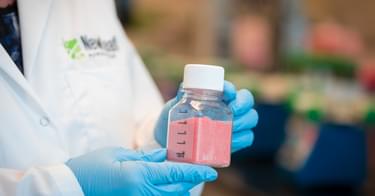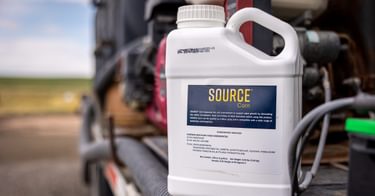
The Fertilizer Dilemma: Solutions from Precision Ag to Alternative Nutrient Sources

This article is the last of our three-part series on fertilizer. In the first installment, we looked at the supply chain issues that have led to high fertilizer prices and the environmental concerns encouraging some farmers to move away from synthetic fertilizer. In part two, we heard from two farmers about how they are navigating this moment and adapting their farming systems in response. In this article, we’ll explore technologies and farming systems enabling farmers to use less synthetic fertilizer while maintaining yields.
Our previous articles in this series looked at the current pressures that disincentivize synthetic fertilizer use, namely rising prices and growing awareness of environmental impacts and regulations. But we believe the concern for farmers looking to use less fertilizer is that their crops won’t receive enough nutrients, which will impact their yield. Fortunately, there are a rapidly growing number of technologies and practices that have the potential to enable farmers to reduce their synthetic fertilizer applications without adverse consequences.

Precision Agriculture
Imagine you’re cooking for a dinner party. You don’t know exactly how hungry everyone will be when they arrive and how much they will eat, so you would probably err on the side of overcooking instead of (gasp) running out of food. Until recently, farmers have generally taken a similar approach to fertilizer application.
Because farmers have historically not had access to advanced soil insights, they have tended to overapply fertilizer. Overapplication has worsened over time, and nitrogen use efficiency has decreased by 22 percent since 1961. Today global nitrogen efficiency use is 46 percent.
Precision agriculture is an approach to farming that uses high-tech sensors and analysis tools to more effectively use crop inputs to improve soil and plant health and productivity. Precision agriculture technologies can help farmers understand exactly how much fertilizer to apply based on the particular needs of a specific area of soil. Improving nutrient efficiency can, in turn, save farmers money while minimizing environmental impacts.

Today, new technologies enable farmers to have unprecedented insights into their soil. Companies such as Trace Genomics, EarthOptics, and Arable use soil science, remote sensing, and machine learning to give farmers access to faster, better, and more affordable soil insights. These technologies can tell farmers what kind of fertilizers to apply in what quantities on each precise location of soil. As a result, we believe they can improve the farmer’s ability to make the best management decisions to optimize fertilizer use efficiency, soil health, and yields while minimizing fertilizer runoff.
Other technologies are improving fertilizer efficiency through more effective fertilizer delivery. Controlled and slow-release fertilizers can decrease fertilizer use by 20 to 30 percent of the recommended rate of a conventional fertilizer while achieving the same yield. Additionally, research has shown that subsurface applications of fertilizer near the root zone can substantially improve yields and minimize nutrient loss. Technologies that enable more precise subsurface fertilizer delivery will also improve nutrient use efficiency.
Alternative Nutrient Sources
Another opportunity for reducing synthetic fertilizer use is to unlock other fertilizer sources. Nitrogen, phosphorous and potassium exist in large quantities in the soil and the air but may be locked up or in a form that is not accessible to plants. Two methods for accessing these soil nutrients are biostimulants and chemical stimulants.

Biostimulants or biofertilizers are living microbes that improve plant nutrient access by either mobilizing or increasing nutrient availability in soils. For example, NewLeaf Symbiotics is an agriculture technology company that produces pink pigmented facultative methylotrophs (PPFMs). These microbes are naturally present on nearly every plant and provide a number of benefits to plants throughout the growing season. NewLeaf is developing and commercializing PPFMs for a range of crops to improve nutrient uptake and make crops stronger, more stable, and more immune to abiotic stresses.
According to AgFunder, startups developing biological inputs for crops raised over $892 million in 2021, over double their total funding in 2020. Investment bank Rabobank projects that the $3 billion biostimulants industry will grow by 12 to 15 percent each year over the next five years. But microbial fertilizers are still largely unregulated, and there are not yet enough studies to determine their effectiveness. Moreover, as we touched on in the last article, farmers are hesitant to shift their practices and rely on new technology without solid evidence that it will work. So despite their potential to improve soil nutrient availability, biofertilizers have yet to replace a substantial portion of chemical fertilizers in commercial agriculture.

Chemical stimulants present another opportunity to take advantage of the nutrients that exist in the soil but are unusable to plants. Plants send chemical signals to microbes, which encourage the microbes to be more active and make more nutrients available to plants. But the increase in fertilizer applications over the past few decades has reduced microbial contributions of nutrients in the soil. Sound Agriculture hopes to reverse this trend with SOURCE, a low use rate foliar spray that activates the soil microbiome by mimicking the signaling molecules that plants naturally release. SOURCE activates both N‑fixing and P‑solubilizing bacteria, giving farmers access to these crucial nutrients. The product gives farmers a new way to boost yield and reduce the need for synthetic fertilizer by up to 50 pounds per acre. Sound’s goal is to reduce global synthetic fertilizer use by 30 percent, which is equivalent to removing 200 million cars from the road.
While chemical and biological technologies offer exciting opportunities to tap into existing nutrient reservoirs, tried and true low-tech farming practices can also boost soil nutrient availability. Crops such as peas, beans and lentils capture nitrogen in the atmosphere and convert it into plant-available nitrogen. Through a process called nitrogen fixation, bacteria that have developed symbiotic relationships with the crops take nitrogen from the air and convert it to a form usable by the plant. This process happens in specialized structures on the plant’s roots called nodules. When the roots die and the nodules decompose, the usable nitrogen is released and is available to subsequent crops for use. We believe growing more legumes as part of a crop rotation or alongside other crops is one of the easiest ways to add more nitrogen to the soil.
Another method — used by both organic and conventional farmers — is nutrient recovery, usually through manure rich in nitrogen, phosphorous, potassium, and other nutrients plants need. While manure is a common form of nutrient recovery in agriculture, organic residuals can include food and crop remains converted into compost or even human waste. In recent decades, significant research and development has been done into the comprehensive recovery of nutrients contained in human waste.
Emissions Free Ammonia
Last, a potential solution for environmentally friendly fertilizer that we believe would not just be a game-changer for the agricultural industry but for energy use in general, is green ammonia. Green ammonia means the process of making ammonia that is entirely renewable and free of carbon emissions. Currently, ammonia production, required to make fertilizer, is very energy intensive. The industry is responsible for about 2 percent of global carbon emissions.
The Haber Bosch process, the method we used to produce ammonia, does so by stripping hydrogen from natural gas using steam and then combining hydrogen with nitrogen at high pressure and temperatures. This process releases 1 – 3 tons of CO2 into the atmosphere for every ton of ammonia it produces. Cutting emissions from ammonia production would mean taking natural gas out of the process and instead using a clean energy source to split water and obtain hydrogen.
There is a lot of excitement around green ammonia and for good reason. Studies from the University of Minnesota have shown that using green ammonia for fertilizer, fuel, and heat could reduce farming’s carbon footprint by as much as 90 percent for corn and small grain crops. Wind-driven green ammonia plants have been operating in England and Japan since 2018, and US-based CF industries, currently the world’s largest ammonia producer, plans to complete a green ammonia plant in Louisiana in 2023 that will produce 20,000 tons per year. But the largest planned project goes to Saudi Arabia. The plant is expected to produce 1.2 million tons of green ammonia annually and is scheduled to open in 2025.
But while there is a lot of activity in the green ammonia sector, it still makes up only a very small portion of global ammonia production. Scaling up is achievable with available technology but expensive. Today ammonia made at a big plant in the US using fossil fuels is 73 percent cheaper than electrically produced ammonia. But as wind and solar costs continue to drop and production technologies advance, we believe green ammonia will become as cheap or cheaper than fossil fuel-based ammonia. The question is just when.
It is our view that precision agriculture and technologies and methods that utilize alternative nutrient sources will enable the agricultural industry to become less dependent on energy-intensive synthetic fertilizers resulting in a win-win of cost savings for farmers and reduced environmental impacts of fertilizer applications. In all likelihood, we will need a combination these technologies to ensure a sustainable and resilient future for agriculture nutrient inputs.
While the pressures to reduce fertilizer use are certainly not ideal for many farmers right now, especially in developing countries where yields are already lower, we believe these circumstances could fuel the innovation and investment needed to find more equitable, environmentally responsible, and resilient solutions to providing crops with necessary nutrients. The farmers we spoke to for this series made it clear that they are looking for better options for their farm and their bottom lines while reducing their environmental impact. They just need to see that they work. It is great to see a number of companies already making an impact in the space. We look forward to learning about the growing number of solutions addressing this timely need and opportunity.


